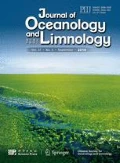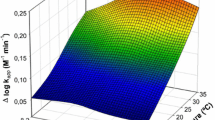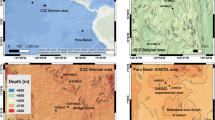Abstract
A study was conducted on Cu, Zn, Cd, Fe, Co and Ni levels in Saanich Inlet anoxic seawater. Data on the concentration of these trace metals and H2S, and other oceanographic parameters were obtained in four cruises.
Equilibrium models are presented together with in situ data. The results strongly support the assumption that the solubilities of Cu, Zn, Cd, Fe, Co and Ni are controlled by bisulfide and/or polysulfide complexes. The species of Cu, Zn, Cd and Ni are shown to be Cu(S4) 3−2 and Cu(Sn4S5)3−, Zn(HS) 02 and ZnHS −2 , Cd(HS) 02 and Ni(HS) 02 , respectively. The solid species controlling Fe2+ and Co2+ are respectively the pyrohotites FeS and CoS. The data illustrates that thermodynamic equilibrium has been established in the H2S-controlled seawater of Saanich Inlet, and that equilibrium has not been established in the H2S−O2-coexisted seawater of Saanich Inlet. The lack of equilibrium in the H2S−O2-coexisted seawater is a result of the flushing or mixing of oxygenated seawater with anoxic water. The new species of trace metals are still in the processes of reduction and precipitation.
Similar content being viewed by others
References
Anderson, J.J. and Devol, A.H., 1973. Deep water renewal in Saanich Inlet, an intermittently anoxic basin.Estuarine and Coastal Marine Science I: 1–10.
Boulegue, K. and G. Michard, 1978. Costantes de formation des ions polysulfures S 2−6 , S 2−5 , et S 2−4 en Phase Aqueuse.Journal Francais d’Hydrologie 9: 27–34 (in French).
Boulegue, J. and G. Michard 1979. Sulfur Speciations and Redox processes in Reducing Environments.In: Chemical Modeling in Aqueous Systems, (Jenne, ed.) ACS Symposium Series 93. Washington, DC, pp. 25–50.
Boulegue, J., 1983. Trace Metals (Fe, Cu, Zn, Cd) in Anoxic Environments.In: C.S. Wong et al. (Editors), Trace Metals In Sea Water. Plenum Press. New York, pp. 563–579.
Cline J.D. 1969. Spectrophotometric determination of hydrogen sulfide in natural waters.Limnology and Oceanography 14: 454–458.
Cloke, P.L., 1963. The geologic role of polysulfides Pt. 2: The solubility of acanthite and covellite in sodium polysulfide solutions.Geochim. et. Cosmochim. Acta 27: 1299–1319.
Danielsson, L-G., B. Magnusson and S. Westerlund, 1978. An improved metal extraction procedure for the determination of trace metals in sea water by atomic absorption spectrometry with electrothermal atomization.Anal. Chim. Acta 98: 47–57.
Davies-Colley, R.J., P.O. Nelson, and K.J. Williamson, 1985. Sulfide control of cadimium and copper concentration in anaerobic estuarine sediments.Marine Chemistry 16: 173–186.
Dyrsson, D. and M. Wedborg, 1980. Major and Minor Elements, Chemical Speciation in Estuarine Water.In: E. Olauson and I. Cato (Editors), Chemistry and Biogeochemistry of Estuaries, John Wiley, New York, pp. 71–119.
Emerson, S., L. Jacobs and B. Tebo, 1983. The Behavior of Trace Metals in Marine Anoxic Waters: Solubilities at the Oxygen-Hydrogen Sulfide Interface.In: Trace Metals in Sea Water, C.S. Wong et al. (Editors). Plenum Press, New York, pp. 579–608.
Gardner, L.R., 1974. Organic versus inorganic trace metal complexes in sulfidic marine waters-some speculative calculation based on available stability constants.Geochim. Cosmochim. Acta 38: 1297–1302.
Kremling, K., A. Wenck and C. Osterroht, 1981. Investigation on dissolved copper-organic substances in Baltic Water.Marine Chem. 10: 209–219.
Kremling, K., A. Wenck and C. Osterroht, 1983. Variation of Dissolved Organic Copper in Sea Water.In: C.S. Wong et al. (Editors). Trace Metal in Sea Water. Plenum Press, New York, pp. 609–620.
Kremling, K., 1983. The behavior of Zn, Cd, Cu, Ni, Co, Fe and Mn in anoxic Baltic Waters.Marine Chem.,13: 87–108.
Leckie, J.O. and R.O. James, 1974. Control Mechanism for Trace Metals in Natural Waters,In: A.J. Rubin (Editor): Aqueous Environmental Chemistry of Metals. Ann Arbor Science, MI pp. 1–76.
Lee, J., 1981. The use of reverse phase liquid chromatography for studying trace metal-organic associations in natural water.Water. Res. 15: 507–509.
Mackey, D.J., 1983. Metal-organic complexes in sea water—An investigation of naturally occurring complexes of Cu, Zn, Fe, Mg, Ni, Cr, Mn and Cd using high-performance liquid chromatography with atomic fluorescence detection.Marine Chem. 13: 169–180.
Mantoura, R.F.C., A. Dickson and J.P. Riley, 1978. The complexation of metals with humic materials in natural waters.Estuarine and Coastal Marine Science 6: 387–408.
Mills, G.L. and J.G. Quinn, 1981. Isolation of dissolved organic matter and copper-organic complex from estuarine water using reverse phase liquid chromatography.Marine Chem. 10: 93–102.
Mills, G.L., A.K. Hanson, J.G. Quinn, W.R. Lammila and N.D. Chasteen, 1982. Chemical studies of copper-organic complexes isolated rom estuarine water using C18 reverse phase liquid chromatography.Marine Chem. 11: 355–377.
Piotrowicz, S.R., G.R. harvey, M. Springer-Young, R.A. Courant and D.A. Boran, 1982. Studies of Cadmium, Copper and Zinc Interactions with Marine Fulvic and Humic Materials in Sea Water Using Anodic Stripping Voltammetry,In: Trace Metals in Sea Water. C.S. Wong et al. (Editors). Plenum Press, New York, pp. 699–718.
Robie, R.A., B.S. Hemingway and J.R. Fisher, 1978. Thermodynamic properties of minerals and related substances at 298.15 K and 1 Bar (1015 pascals) pressure and at higher temperature.U.S. Geologic Survey Bulletin 1452: 457.
Smith, P.M. and A.E. Martell, 1976. Critical Stability Constants, Vol. 4. Inorganic Complexes, Plenum Press, New York, 257 pp.
Snellgrove, R.A. and H.L. Barnes, 1979. Solubilities of Ore Minerals (H.L. Barnes)In: “Geochemistry of Hydrothermal Ore Deposits”, 2nd ed. (Barners, ed.), Wiley-Interscience.
Stukas, V.J. and C.S. Wong, 1983. Accurate and Precise Analysis of Trace Metals of Cu, Cd, Zn, Fe, and Ni in Sea water by Isopic Dilution Mass Spectrometry,In: Trace Metals in Sea Water. C.S. Wong et al. (Editors). Plenum Press, New York, pp. 513–534.
Stumm, W. and J.J. Morgan, 1981. Aquatic Chemistry. John Wiley, New York, 780 pp.
Van den Berg, C.M.G., 1985. Determination of the zinc complexing capacity in sea water by cathodic stripping voltammetry of zinc-APDC complexes ions.Marine Chem. 16: 121–130.
Wong, C.S., K. Kremling, J.P. Riley, W.K. Johnson, V. Stukas, P.G. Berrang, P. Erichaon, D. Thomas, H. Peterson and B. Imber, 1983. An Intercomparison of Sampling Devices and Analytical Techniques Using Sea Water,In: Trace Metal in Sea Water. Plenum Press, New York, pp. 175–194.
Author information
Authors and Affiliations
Additional information
Contribution No. 1428 from Institute of Oceanology, Academia Sinica
Rights and permissions
About this article
Cite this article
Binqiu, Z., Wong, C.S. & Johnson, W.K. Controlling mechanisms for the trace metals, (Cu, Zn, Cd, Fe, Co and Ni) in anoxic sea water in Saanich Inlet, British Columbia, Canada. Chin. J. Ocean. Limnol. 5, 193–204 (1987). https://doi.org/10.1007/BF02843983
Received:
Issue Date:
DOI: https://doi.org/10.1007/BF02843983




